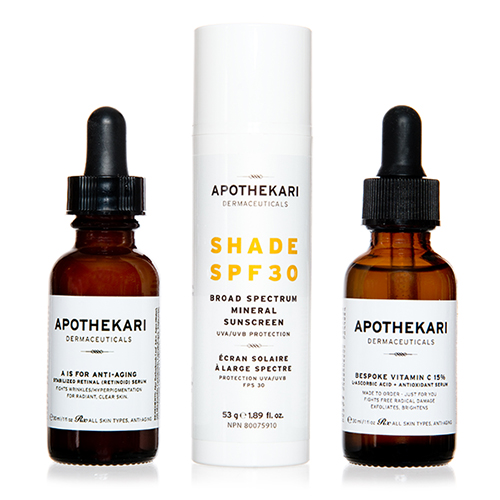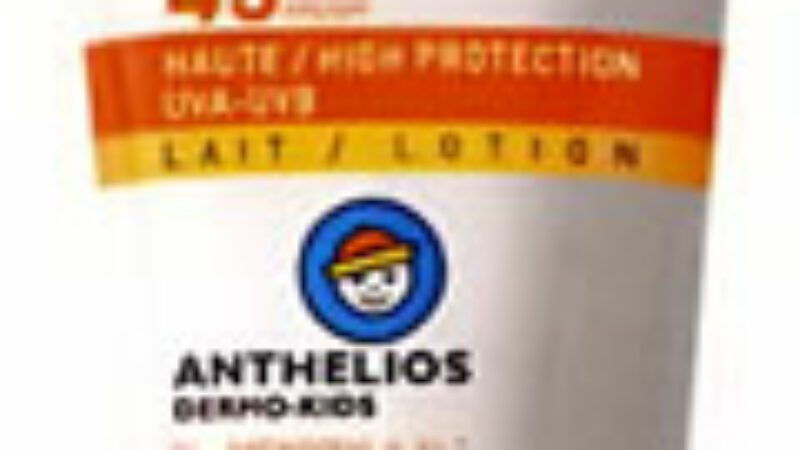Following on our last post discussing aging skin, let’s look at aging skin products that can help keep skin looking young and vibrant no matter your age.
While we have yet to discover the fountain of youth when it comes to aging, science has given us solutions that can help to delay the inevitable. If you’re concerned about skin roughness, uneven skin tone, brown patches, age spots, thin skin and wrinkles, there are some aging skin products and procedures to consider. In this article, let’s take a closer look.
Aging Skin Products & Treatments
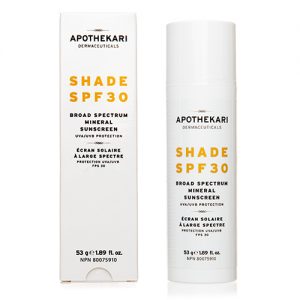 Sun Protection. It’s well known that exposure to the sun’s ultraviolet rays is the main cause of skin aging so we can’t discuss aging skin products without mentioning sunscreens. A well formulated sunscreen is THE MOST IMPORTANT aging skin product to include in your arsenal. Sunscreen protects against extrinsic aging (factors that occur outside our bodies), including exposure to sunlight and pollution.
Sun Protection. It’s well known that exposure to the sun’s ultraviolet rays is the main cause of skin aging so we can’t discuss aging skin products without mentioning sunscreens. A well formulated sunscreen is THE MOST IMPORTANT aging skin product to include in your arsenal. Sunscreen protects against extrinsic aging (factors that occur outside our bodies), including exposure to sunlight and pollution.
In general, choose a broad spectrum product that protects against UVA and UVB rays and is photo-stable. Apothekari Shade SPF 30 can’t be beat for it’s non-whitening, zinc oxide and antioxidant enhanced protection. A water resistant formulation is necessary if conditions warrant. Apply sun protection daily, year round – prevention really is one of the best strategies you can employ. Our post on choosing the safest sunscreen (the most effective too) is a good read if you are looking for guidance regarding product choice. And our store at PhaMix.com stocks a selection of the most effective and best-selling sunscreens you’ll find anywhere.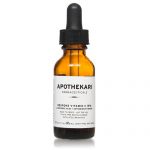 Antioxidants. Antioxidants provide protection against free radical damage caused by exposure to UV rays, especially in the stratum corneum, the uppermost skin layer that sits on top of the epidermis. This process helps to reduce collagen degradation. While skin contains some naturally occurring antioxidants such as superoxide dismutase, catalase, alpha-tocopherol, ascorbic acid, ubiquinone, and glutathione, the application of topical antioxidants and a diet rich in antioxidants helps to increase the protection.
Antioxidants. Antioxidants provide protection against free radical damage caused by exposure to UV rays, especially in the stratum corneum, the uppermost skin layer that sits on top of the epidermis. This process helps to reduce collagen degradation. While skin contains some naturally occurring antioxidants such as superoxide dismutase, catalase, alpha-tocopherol, ascorbic acid, ubiquinone, and glutathione, the application of topical antioxidants and a diet rich in antioxidants helps to increase the protection.
Vitamins C, B3, and E are considered to be the most important antioxidants because they penetrate the skin easily. When vitamins C and E are combined, their antioxidant ability is higher than with either one used alone. Vitamin B3 (niacinamide) regulates cell metabolism and regeneration and has been shown in some studies to help improve skin elasticity, redness and pigmentation. Our Bespoke Vitamin C Serum contains an arsenal of antioxidants including vitamins c and e along with green tea extract plus other skin beneficial ingredients.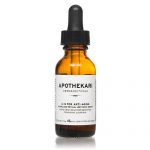 Cell Communicating Agents/Cell Regulators. In particular, retinoids, including prescription retinoic acid and its derivatives along with over the counter options such a retinol, retinaldehyde and retinyl palmitate. These ingredients work to inhibit the breakdown of collagen and promote its synthesis, helping to maintain the skin’s structural integrity. Our A is for Anti-Aging Serum contains gentle, yet effective retinaldehyde plus other ingredients that deliver photo-aging protection, exfoliate, provide anti-inflammatory/anti-irritant benefits and brighten skin. As an added benefit, retinaldehyde shows anti-bacterial properties towards the acne causing bacteria, P. acnes.
Cell Communicating Agents/Cell Regulators. In particular, retinoids, including prescription retinoic acid and its derivatives along with over the counter options such a retinol, retinaldehyde and retinyl palmitate. These ingredients work to inhibit the breakdown of collagen and promote its synthesis, helping to maintain the skin’s structural integrity. Our A is for Anti-Aging Serum contains gentle, yet effective retinaldehyde plus other ingredients that deliver photo-aging protection, exfoliate, provide anti-inflammatory/anti-irritant benefits and brighten skin. As an added benefit, retinaldehyde shows anti-bacterial properties towards the acne causing bacteria, P. acnes.
Peptides are another class of cell communicating ingredients which have the ability to stimulate collagen synthesis.- Chemical Peels/Exfoliants. Chemical peels work by using a mixture of ingredients to help remove topical skin layers to deliver more evenly toned and tighter skin. A number of ingredients may be used as peeling agents and the depth of the peel relies on the substance used, its concentration, pH and time of application.
You can purchase peels for at home use, which contain alpha hydroxy acids and beta hydroxy acids. View a range of exfoliants at our sister store PhaMix.com here. Because they don’t penetrate very deeply, they are safe and will deliver brighter looking skin. For longer lasting and more dramatic results, you can seek the help of a trained professional to conduct a deeper peel. Depending on the depth of the peel, you can expect an increase in collagen and more hydrated skin. Skin elasticity and wrinkles have also been shown to improve. While you get more dramatic results with deeper peels, the risk for side effects also increases. Hyperpigmentation, solar lentigines and the risk of post-operative infections are some of them. - Visible Light Devices. Intense Pulsed Light (IPL) & Lasers are newer technologies that come with lower risk and shorter downtime than chemical peels and can improve the structure of the skin. The process relies on lasers, which emit light at varying wavelengths to stimulate new collagen formation. The absorption of light results in the release of inflammatory agents, which in turn stimulate new skin cell development, initiate tissue repair and enhance collagen and elastin formation. Different treatments have varying clinical effects so it is important to work with a trained professional to help select the procedure most suitable for your skin.
- Injectables and Fillers. The goal for injectables is to increase the ability of fibroblasts (responsible for the production of skin cells), enhance cell activity, increase hydration, and the synthesis of collagen, elastin and HA (hyalorunic acid). This is accomplished through the use of microinjections in the dermis with products containing either one active ingredient or a cocktail of different compounds: HA, vitamins, minerals, nutrients, hormones, growth factor, amino acids, etc. Platelet rich plasma (PLP), derived from fresh, whole blood is another ingredient that may be used. More detailed studies are required to evaluate just how effective these protocols are.
Fillers, on the other hand, are aging skin products which are injected within or beneath the skin to improve its physical features. These include ingredients such as fat, cultured human fibroblasts, collagen (bovine-derived, human-derived from tissue culture), HA , synthetic or pseudo-synthetic implants (silicone, polymethacrylate microspheres, poly-L-lactic acid, calcium hydroxylapatite microspheres suspended in aqueous polysaccharide gel, alkyl-imide gel polymer). Their effects may be temporary, semipermanent (lasting between 1–2 years), or permanent materials (lasting longer than 2 years). - Botox. Botulinum toxin (BTX) has no effect on skin texture and doesn’t stop the skin aging process. However, regular injections can slow down the visible aging process by helping to reduce certain dynamic facial lines and wrinkles.
- Hormone Replacement Therapy. As we get older, we synthesize less hormones including growth hormone (GH), and insulin-like growth factor-1 (IGF-1), melatonin (nocturnal), thyroid hormones, dehydroepiandrosterone (DHEA), estrogens, progesterone and testosterone. Studies have shown that supplementation with hormones including DHEA, GH, testosterone (in men), estrogen and progesterone (in women) are associated with a number of beneficial effects including an improvement in skin health.
HRT, despite its benefits, has also been associated with negative effects including an elevated cardiovascular risk and increase of the risk of breast cancer. Given the potential for serious side effects, the decision to pursue hormone replacement therapy is something that individuals should discuss with their physician. - Plastic Surgery. The most invasive of all procedures, plastic surgery is a consideration for individuals who aren’t satisfied with any of the above treatment options. Plastic surgery can help to correct wrinkles, restore (and redistribute) fat and volume loss, augment skin and contour it. It delivers the most noticeable difference to skin. However, this medical procedure comes with a cost – including a high price tag and the potential for medical problems. If you feel that it’s right for you, consult with an experienced and qualified health care professional.
I’d be remiss in this post if I didn’t discuss the importance of lifestyle factors in helping to keep skin looking healthy. Not specifically an aging skin product, the impact of influences including sound nutrition, stress management, adequate sleep, physical activity and the avoidance of smoking, excessive alcohol consumption and too much sun can’t be underestimated. As with most things health related, prevention is best and it’s no different when it comes to that of your skin.
We’ve covered a lot of different aging skin products in this post. Which are you using? Any you’re curious to try?

